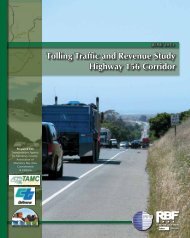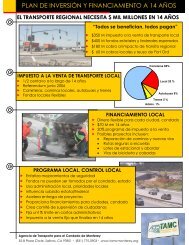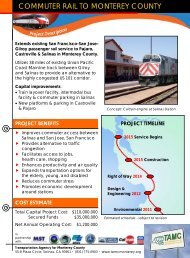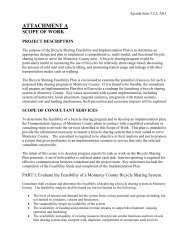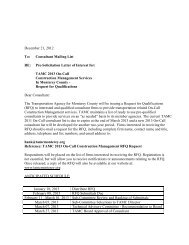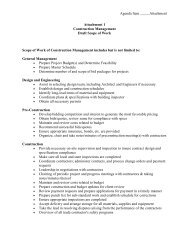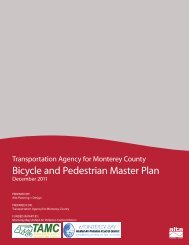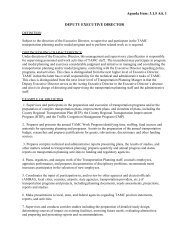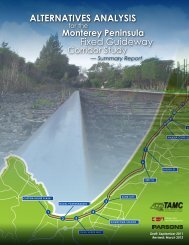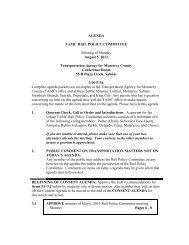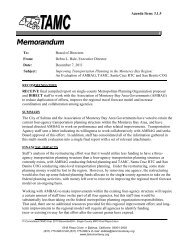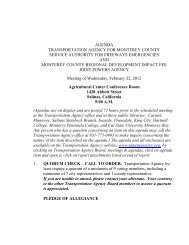Commuter Rail Extension Alternatives Analysis - Transportation ...
Commuter Rail Extension Alternatives Analysis - Transportation ...
Commuter Rail Extension Alternatives Analysis - Transportation ...
You also want an ePaper? Increase the reach of your titles
YUMPU automatically turns print PDFs into web optimized ePapers that Google loves.
CALTRAIN EXTENSION TO MONTEREY COUNTYALTERNATIVES ANALYSISthe former Pajaro passenger station. The building is used by UPRR yard personnel and is indisrepair, with the majority of the fenestration boarded. The passenger station is currently not inpublic service and would be removed by the county to construct a community center/station building.The building is not historic.Only freight operations have been continuous since the opening of the railroad line in July of 1871.Along with the passenger station, a small, adjunct metal <strong>Rail</strong>road Express Agency operations buildingand weathered wood-framed Southern Pacific smoke house (also known as the tool building), locatedto the south and to the north of the station building, respectively, are the only structures remaining onthe former Southern Pacific <strong>Rail</strong>road site. Commercial and a few residential properties are locatedalong Salinas Road in the project area; however, most of the surrounding land use to the east, south,and west is agricultural.Castroville Station/Park-and-Ride SiteThe community of Castroville is located in northern Monterey County, at the northern end of theSalinas Valley. Castroville is approximately 8 miles northeast of the city of Salinas, 5 miles west of thecommunity of Prunedale and is located at the junction of three major tourist and commuter-servinghighways (Highway 1, Highway 156 and Highway 183). Castroville is surrounded by agricultural landand is the center of the largest artichoke-growing region in the world. The community remainspredominately agricultural in its land use character and industries.The Castroville passenger station site is at the edge of an agricultural swale that lies just north of theSR 156 overcrossing of the UPRR main line on the east side of the unincorporated community ofCastroville (see Figure 5-3). Agricultural land makes up most of the site and all the lands to the north,and is bordered on the south by the Caltrans SR 156 transportation corridor and the stubs of CollinsRoad and Benson Road. The General Plan maps this site as Agricultural Preservation–Coastal. Thesite is designated farmland in the North County Area Plan. The site includes the following agriculturalzoning designations: Coastal Agricultural Preserve (Coastal Zone), Resource Conservation (CoastalZone), and Farmland, 40-acre minimum.The California Coastal Commission was established by voter initiative in 1972 (Proposition 20) andwas made permanent by the legislature through adoption of the California Coastal Act of 1976. TheCoastal Commission, in partnership with coastal cities and counties, plans and regulates the use ofland and water in the Coastal Zone. Development activities, which are broadly defined by the CoastalAct to include (among others) construction of buildings, divisions of land and activities that changethe intensity of use of land or public access to coastal waters, generally require a coastal permit fromeither the Coastal Commission or the local government. The policies of the Coastal Act constitute thestatutory standards applied to planning and regulatory decisions made by the Commission and bylocal Governments, pursuant to the Coastal Act. Implementation of Coastal Act policies isaccomplished primarily through the preparation of Local Coastal Programs that are required to becompleted by every county and city located within the Coastal Zone. Completed Local CoastalPrograms must be submitted to the Commission for review and approval. A Local Coastal Programincludes a land use plan that prescribes land use classifications, types and densities of allowabledevelopment, goals and policies concerning development and zoning ordinances necessary toimplement the plan. Amendments to certified land use plans and Local Coastal Programs onlybecome effective after approval by the Commission.The Castroville site is located within the Coastal Zone. Therefore, development within this area mustbe consistent with policies of the Coastal Act.parsons CHAPTER 5: ENVIRONMENTAL ANALYSIS 123



